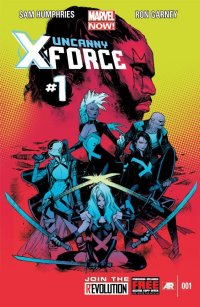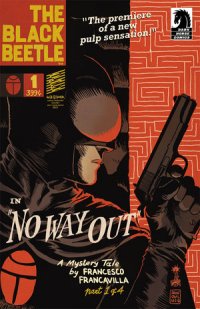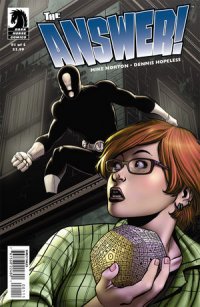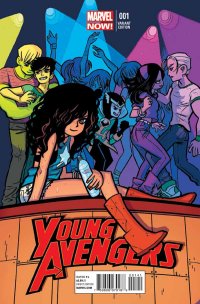Uncanny X-Force #1 (Marvel, $3.99)
By Adam Prosser
My New Year’s resolution is to read more Marvel. Yeah, pretty lame, I know, but I figure, why not make resolutions you can stick to?
I’ve always been a DC guy over a Marvel guy, but that’s more because my formative experiences with comics were largely with DC (and Vertigo) comics, thanks largely to the holy trinity of Alan Moore, Neil Gaiman and Grant Morrison. Marvel had been a bit of a mess for much of my lifetime—a corporate Evil Empire or a bankrupt IP farm, a participant in the boom-and-bust cycle of the early 90s, a company mostly pandering to the lowbrow and leaping from trend to trend. I’m not saying they never produced anything interesting in the 80s, 90s, and 00s, but its philosophy as a company was something that mostly kept me at a distance.
In the last few years, though, it’s become impossible not to notice a paradigm shift at the House of Ideas, one that seems contingent with the rise of Marvel Studios and a string of hit movies made from its characters, plus of course the purchase of the studio by Disney. Even as DC seems to be spiralling the drain, Marvel’s been hiring exciting creators, taking interesting creative chances, and renewing its focus on FUN over grim ‘n’ gritty posturing. Even the thing that’s made Marvel somewhat more inaccessible over the years, its proud history of continuity, has been scaled back and made more comprehensible to the new reader.
This is largely in evidence in Uncanny X-Force #1, by Sam Humphries and Ron Garney. The X-books are something I’ve traditionally stayed far, far away from, these being the series that exhibited all the worst tendencies I associate with Marvel (and comics in general), particularly during the bleak years of the early 90s. But too many people have recommended various X-Men titles to me in the last year or so for my curiosity to go unpiqued. Sure enough, this comic turns out to be a surprisingly good time, even to a mutantphobe like me.
The focus is on Betsy Braddock, aka Psylocke (which, right there, is planting the book’s flag rather boldly in the early 90s). The plot’s pretty straightforward: she and Storm are sent out by Wolverine to rendezvous with Puck—that’s the garrulous little person from Alpha Flight—in Los Angeles and investigate strange goings-on in the club scene, where a designer drug is causing ravers to behave as a hive mind. The mastermind behind all this turns out to be multi-armed X-Nemesis Spiral—or is it? Meanwhile, other characters are doing stuff all over the world, including a thief named Fantomex who’s apparently been split into three people, one of whom is a woman with whom he’s now having a love affair, and the third is evil.
Comics!!!
Obviously the events preceding this story are as insane as you could ever ask, but to anyone who gets the gist of superhero comics in general, this issue is surprisingly clear and accessible to a new reader. Someone who’d never picked up a comic in their life might be baffled, but as long as you accept that “weird stuff’s happened” to get the characters where they are now, this comic is a model of efficient storytelling. Humphries is able to hit the basics without a lot of extended flashbacks or bloated exposition; in most cases, we’re given a terse recap via a caption, or sometimes even a silent panel is enough to get the point across. What’s even more impressive is that, as someone who doesn’t know some of these characters at all, I was never lost as to their relationships. Sometimes there’s a bit of a cheesy old-school feel to the captions, but there’s a reason comics—especially Marvel comics–relied on these techniques for decades. In a similar vein, Garney’s style is fairly generic, but his compositions are effective and his storytelling is clear and expressive. In short, this is a book that emphasizes craft and clarity, and in the tangled, confusing world of the X-Men, that’s something that deserves a cheer.
Rating: 




Out of a Possible 5 Stars
 The Black Beetle: No Way Out #1/The Answer! #1 ($3.99 each, Dark Horse Comics)
The Black Beetle: No Way Out #1/The Answer! #1 ($3.99 each, Dark Horse Comics)by D.S. Randlett (@dsrandlett)
It’s been a staple practice of Dark Horse’s line of original titles to look toward pre-superhero pulps for inspiration for quite a few years now. The company probably first expressed this tendency in the earliest Hellboy comics, which pulled from pulp icons like H.P. Lovecraft’s Ancient Ones for most of the series’ antagonists, and nighttime avengers/spies like The Spider for Lobster Johnson. To their credit, Dark Horse’s affection for this era in heroic entertainment is entirely genuine, as can be seen in their efforts to put out definitive editions of classic pulp material like their Robert E. Howard collections of Conan and Solomon Kane stories. To be honest, the pulp hero genre has always been of more academic interest to me. It’s never been material that I’ve really connected to outside of a distant appreciation. It’s a stage of American heroic storytelling that is in a limbo between the Western and the Superhero, but the genre trappings of many pulp vigilantes still feel oddly British or European, something symptomatic of an emerging industrial giant struggling to find a heroic voice for its own urban experience. The pulps are interesting because they are the documents of a nation in flux, a nation finding a new aesthetic that can express a new cultural experience.
As such, it’s always odd to me that storytellers find so much inspiration in the genre, and that we give it so much rope. The shadowy pulp aesthetic is, to be sure, exciting and appealing, but it has never seemed to have much to say. This is pretty much the case with Francesco Francavilla’s The Black Beetle. Francavilla’s narrative, much like the pulp hero stories of yore, is focused on getting the title character into evocative poses and adventuresome situations that Francvilla can make look cool. There’s a mystery afoot (who killed all the crime bosses before Black Beetle could bring them to justice?), but it’s not used, as in the best noir, to explore something about the character or human nature, but to serve Francovilla’s art.
And it works. The Black Beetle is shallow, but it’s the best kind of shallow. Francovilla’s art is simply some of the best that you can find this month, and some of his layouts are truly inventive. He’s thinking about his storytelling as an artist first, and a writer second. He moves his story along not so much in terms of events or plot beats, but rather in terms of his next layout. The experience of reading (regarding might be a better word) The Black Beetle is much like hanging out at a favorite bar. You’re not going there for a specific experience of any sort of import, but to dig the cool vibe, and the vibe of The Black Beetle is very, very cool.
There is another Dark Horse entry into their pulp vigilante stable with this week’s The Answer! It’s an obvious nod and  wink to Steve Ditko’s classic superhero, The Question, and the design of the title character is, indeed, very Ditko. Where The Black Beetle was a breezy and nearly plotless romp fueled by its art, The Answer! is driven entirely by its plot and writing to the point that it could be a radio play. The Answer himself has some elements that are very reminiscent of The Shadow. It’s implied the The Answer is part of some sort of vigilante network. Or it would appear to be, as the plot unfolds from the point of view of a young, puzzle obsessed librarian who finds herself drawn into a shadowy world of… we don’t exactly know yet. But it does involve rooftop chases and toughs with assault rifles.
wink to Steve Ditko’s classic superhero, The Question, and the design of the title character is, indeed, very Ditko. Where The Black Beetle was a breezy and nearly plotless romp fueled by its art, The Answer! is driven entirely by its plot and writing to the point that it could be a radio play. The Answer himself has some elements that are very reminiscent of The Shadow. It’s implied the The Answer is part of some sort of vigilante network. Or it would appear to be, as the plot unfolds from the point of view of a young, puzzle obsessed librarian who finds herself drawn into a shadowy world of… we don’t exactly know yet. But it does involve rooftop chases and toughs with assault rifles.
The Black Beetle revels in pulp’s past, mining an aesthetic. The Answer! is decidedly modern, with a cartoonier style and a snarkier edge to the dialog. It’s the action-comedy version of The Shadow, with secret organizations fighting for both good and evil. Also, evil TED talks.
As a piece of craft, The Answer! is hardly up to the standards of The Black Beetle, but it’s competently done. The script by Dennis Hopeless uses a voice that’s very derivative of Joss Whedon’s style, but like many of Whedon’s imitators he fails to write characters that really stick. He comes up with some fun lines and moves the plot along, but ultimately Hopeless fails to really get at the heart of why that style works for writers like Whedon or Vaughn: it feels natural to their characters. Here, the tone feels like artifice rather than natural characterization. However, the story moves and is a lot of fun, with a really neat towards the end twist at the end of this issue. Mike Norton’s art is on the whole, well done. It’s very workmanlike and up to the task of the story, nothing more and nothing less.
Dark Horse has been moving away from their pulp template with titles like The Massive and Mind MGMT, but they’re still the premier publisher of new pulp stories in the comics medium, and these two very solid entries testify to that fact.
The Black Beetle: Rating: 




Out of a Possible 5 Stars
The Answer!: Rating:





Out of a Possible 5 Stars
 Young Avengers #1 (Marvel, $3.99)
Young Avengers #1 (Marvel, $3.99)By Jeb D.
Who ever imagined Kate (Hawkeye II) Bishop as Marvel’s MVP? In the demanding world of corporate superheroes, where flagship characters are expected to shoulder the sales responsibilities of multiple titles each month, appearing in two unrelated series isn’t necessarily remarkable: but it’s definitely noteworthy when a “secondary” character is a key player in what could be the two best titles Marvel is currently publishing.
OK, that’s maybe a stretch, given that one of the series is just starting (and that Kate’s not really the central figure of either), but not that much of one: less than a year in, there’s no question that Matt Fraction’s Hawkeye, with art by David Aja and Javier Pulido, is the perfect marriage of modern storytelling sensibilities with old-school superhero fun; and if Young Avengers can continue as strong as it starts, I’ll have no trouble doubling down on that 1-2 statement.
In a way, this is exactly the Marvel book you’d have expected the Phonogram team (writer Kieron Gillen and artist Jamie McKelvie, with Mike Norton, and colors by Matthew Wilson) to come up with: brisk, deft characterization, art that blends strong traditional storytelling with explosions of innovative layout, and dialog that manages to convey the adolescent experience without an incessant barrage of “kool” pop-culture references.
This first issue is mostly about setting the stage, and introducing (and re-introducing) characters that will be unfamiliar even to many regular Marvel readers (particularly those that dismissed Allan Heinberg and Jim Cheung’s brilliant original Young Avengers on the basis of its title alone). Given that, McKelvie makes sure to keep things visually interesting, particularly during the innovative double-page action spreads, and backs Gillen with his ability to convey the fluid visual experimentation of adolescence, again without relying on specifically dated style references. We open on Kate waking up after a night of passion with Noh-Varr, and being nearly as lost as the reader. That’s put quickly to rights with some snappy exposition, followed by the first of the book’s delightfully giddy double-page action scenes. That there will be lots of adolescent romance is a given, but even the surprisingly frank depiction of Wiccan and Hulkling’s relationship is not extraneous, but closely tied in with the book’s examination of “power and responsibility” (the original team broke up with a pledge to renounce the use of their powers, a resolve that is proving difficult for at least one of the group).
And then there’s Kid Loki, fresh off his dazzling, bittersweet run in Gillen’s Journey Into Mystery: it’s not exactly a spoiler to say that he’s already scheming (and his encounter with Marvel’s current Miss America is a lovely mixture of action and info dump), but by issue’s end, it’s clear that he’s going to have some serious competition in the baddie department for this series. It’s obviously too early to know how well Young Avengers will develop in story terms, but the best superhero comics are the ones that make time spent with the characters equally rewarding, whether they’re punching, smooching, or chatting, and this cast of characters gives plenty of promise in that department.
Gillen has said that he wants this series to show the transformative period between the (roughly) 16-year-olds of Heinberg’s run, and the 18-year-olds he depicts here, on the cusp of adult responsibility. The arc subtitle, “Style > Substance,” feels like an ironic commentary on the power of that transition, because there’s just as much emotional truth underneath as there is super-powered fun on the surface.
Rating: 




Out of a Possible 5 Stars